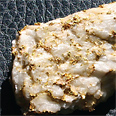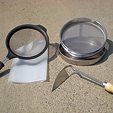Prospecting & Detecting
Backwards Find
July 2013 by Joe Chmiel
You couldn’t ask more from a late winter’s day in February in the Mojave Desert: clear sky, 70-degree temperatures, the gentlest of breezes and...GOLD!I like to hunt club claims, and I find that by maneuvering my coil between rocks and bushes I can sometimes pick out a nugget—or five or six—that others have missed. On this particular day, I was doing my usual thing, picking off nuggets up to 1/2-gram in size. However, my prospecting partner, instead of skimming along the surface, seemed to be lingering extra long in just one place. In fact, he was practically camped on this single spot, digging, detecting, recovering, and repeating the process.
It occurred to me that he might have found a cluster of extra tiny nuggets, the type that only his VLF (very low frequency) detector can pick up. Or maybe he was having trouble pinpointing the responses his detector was giving him. Whatever it was, I knew I had better stay busy if I were to keep up.
Of course I became so engrossed in what I was doing that I failed to notice that for a full two hours my partner had been trying to get my attention to come join him, and he was in a bit of a dilemma about this. On the one hand, he could leave his spot and come get me (running the risk of other nearby nuggetshooters jumping his hole) or he could yell to me to come over (thereby signalling to everyone around that there was something worthwhile to be had). Well, he did neither—he chose to wait until I finally noticed his subtle gesturing and walked over to see what was up.
I was surprised to see that he had a two-foot deep hole going and had already collected about 15 grams worth of nuggets. As for me, I was barely over one gram for my day’s efforts.
Seeing as I was swinging a different VLF detector that wouldn’t interfere with his, he suggested that I dig a hole about 10 feet away from him to see if I might find a similar pocket. It was late in the day and I was already a bit worn out, so I was not looking forward to digging in the blind hope of hitting a pay streak.
.jpg)
But dig I did—and without the benefit of a detector signal, mind you. Picking my way through the bedrock, my hope of hitting a gold-bearing pocket was fading with the late afternoon sun. As soon as I got under the bedrock and into a soft layer I stuck the coil of my detector into the hole. Wham! A solid “zeet-zeet” from the side of the hole greeted my ears, and turning the discriminator function on yielded a solid indication for gold on the detector’s readout.
I furiously started pulling material out of the side wall and putting it in my scoop. It didn’t take long to discover that the source of the scream was from a one-ounce chunk of rock. Almost no gold was immediately visible due the rock being encased in a hardened caliche crust, but one corner gave away its secret. An exposed area of yellow metal indicated that this was indeed a temporary treatment for my gold fever!
I wanted to jump up and down, but because of the other detectorists in the area, I had to play it cool. The prize was slipped quietly into my pouch with no celebration. It was only upon later inspection that I could see this rock was ribboned with gold!
The total weight was just over an ounce, and with some cleaning it will end up under an ounce. But still, finding a specimen piece of this size was a real treat. Oh yeah—the hole held a couple more tiny nuggets and nothing else.
So I guess this was sort of a backwards find. Instead of beeping a target and digging a hole, I dug a hole and then beeped the target. Gold is indeed where you find it!

Nice Specimen Gold Recovered in Northern California
 Each specimen is carefully examined to determine if it would be beneficial or not to use an acid treatment to reveal more of the gold.
Each specimen is carefully examined to determine if it would be beneficial or not to use an acid treatment to reveal more of the gold.
Uncovering the Find of a Lifetime
• The 75-ounce Butte County nugget is the largest found in California since the 156-ounce Mojave nugget in the 1970s...
Commercial Placer Mining: Alaska Style
 There are currently about 170 commercial-scale placer operations in Alaska. Most of these are small operations with just a few people working; they are often family affairs that operate seasonally only during favorable weather.
There are currently about 170 commercial-scale placer operations in Alaska. Most of these are small operations with just a few people working; they are often family affairs that operate seasonally only during favorable weather.
A Third Generation Small-Scale Hardrock Revival
 One of his friends had 700 feet of small-gauge mine track and a hundred-year-old track bender laying out in his back 40; plus he also wanted to join the team. Perfect.
One of his friends had 700 feet of small-gauge mine track and a hundred-year-old track bender laying out in his back 40; plus he also wanted to join the team. Perfect.
Hard Rock Milling: A Matter of Scale
 Most prospectors understand placer mining a lot better than hard rock mining and don’t realize the amount of work that goes into processing different types of hard rock ore.
Most prospectors understand placer mining a lot better than hard rock mining and don’t realize the amount of work that goes into processing different types of hard rock ore.
Sunset Sunbaker
 He began hiking my way and was as astonished as I was when he saw it. Another high five moment! It makes you wonder how long this gold had just been sitting there on the ground.
He began hiking my way and was as astonished as I was when he saw it. Another high five moment! It makes you wonder how long this gold had just been sitting there on the ground.
Prospecting for Liberated Gold
 Some will doubt its value given the ultra-fine particle size… Some will become encouraged about not having to incur significant time and expense to break rock.
Some will doubt its value given the ultra-fine particle size… Some will become encouraged about not having to incur significant time and expense to break rock.
Subscription Required:
The Bawl Mill
• Ask the Experts
• Ask the Experts
• The Birimian Greenstone Belts of West Africa
• Study Confirms Mercury Levels Safe in California's Gold Country
• All About Quartz—Part II
• The Pearce Mineralized Area, Dragoon Mountains, Arizona
• An Alaskan in the Lower 48
• Romancing the Rock
• Placer Channel Sampling
• The Oquirrh Mountains, Utah
• Melman on Gold & Silver
• Mining Stock Quotes and Mineral & Metal Prices
• Record $11 Million Fine for California Mine
Free:
Legislative and Regulatory Update
• Balmoral Resources







